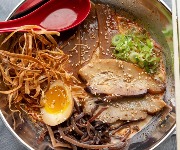A potted history of Worcestershire sauce

There are few store cupboard essentials as quintessentially British as Worcestershire sauce. But how much do we know about this tasty condiment?
Worcestershire Sauce was originally developed by two chemists, John Wheeley Lea and William Henry Perrins. The brand name Lea and Perrins we’ve come to know was commercialised in 1837, and the sauce has been produced in the current Midlands Road factory (above) in Worcester since 1897, making it 114 years old.
Secret ingredients
The ingredients in L&P Worcestershire sauce are: malt vinegar, spirit vinegar, molasses, sugar, salt, anchovies, tamarind extract, onions, garlic, and ‘spice and flavourings’, the secret ingredients which give the sauce its signature taste are believed to include soy sauce, lemons, pickles and peppers. There’s also a fermentation process that produces its signature tangy taste. Interestingly in 2009 what was believed to be the actual recipe was found in a skip.
Enjoyed abroad
In 2005, Heinz purchased the brand but continued to sell and market the sauce as ‘The Original Lea & Perrins Worcestershire Sauce’. Versions of Worcestershire sauce are sold abroad and it is commonly known as ‘English Sauce’ in many Asian countries. Canada enjoys the same variety of the sauce as Brits, but the American version is slightly altered with additional flavourings like chilli pepper and white vinegar in place of malt vinegar. Although many say the taste is indistinguishable from the British variety, some say it’s slightly sweeter and less spicy than the UK version.
Chinese version
In China, a variation of Worcestershire sauce plays a huge role in various cuisines. In Cantonese cuisine, the sauce is used in many foods used like dim sum and spring rolls. In Shanghai cuisine, it’s used in a variety of fusion dishes like Shanghai-style borscht and as a dipping sauce for pork buns and pork cutlets. And while there is a Lea & Perrins plant in Guangdong, China, the English variety does not dominate the market compared to native-grown varieties of the sauce.
Many uses
As for its culinary uses, well there’s plenty, splashed on steaks, Caesar salads and a key ingredient in a Bloody Mary. It’ll add depth to dishes such as spaghetti Bolognese or chilli con carne as well. Then of course there’s the classic cheese on toast.
What’s your favourite dish using this ‘English sauce’? Is it a store cupboard essential or are you a Worcestershire sauce newbie?
Image by Oliver Mallich
More sauce uses
Donal Skehan's buffalo chicken wings
Most Recent
Comments
Be the first to comment
Do you want to comment on this article? You need to be signed in for this feature








